#Oximeter battery
Text
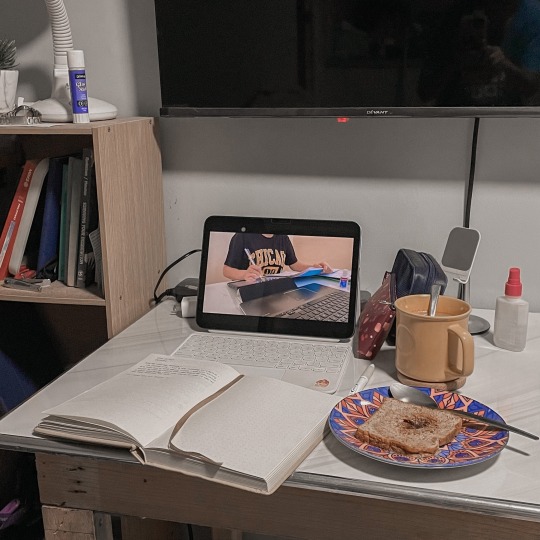
hello! it’s 10 in the morning, and I had been up for hours watching a sketchy video, downloading some anki decks, and answering immunology anki decks. now, you might be wondering why I am studying, if I have any exams due soon. no exams as of the moment. the real studying starts on the week of clerkship, but for now I’m just doing light studying. doing active recall to simulate my brain.
I had a double shot espresso with milk and a toasted bread with melted lurpak butter for breakfast, journaled a bit, and now it’s time to do some cleaning I scheduled for today!
THE big to-do list for saturday
start pharma anki
put basic audit schedule on notion
watch sketchy pharm
watch 2 dirty medicine and ninja nerd videos (physiology preferably)
put batteries on thermometer and pulse oximeter
change bedsheet
clean walls
laundry: curtains
laundry: berry things
sort out files on desk
clean electric fans
workout
ps. I’m trying to fix my body clock since I had been waking up at 10am and sleeping at 3am for the first half of June, and this morning even though I only had 4 hrs of sleep, I woke up at 7am and couldn’t go back to sleep so I started my day early. will probably just nap later. I feel tired, but it’s okay! I’ll get there. I plan on being the morning person I am this clerkship again
#studyspo#studyblr#studycommunity#study#bujo#desk#productivity#bookblr#bullet journal#notebook#tbhstudying#studyquill#featheredstudies#adelinestudiess#lawyerd#stuhde#notebookist#noodledesk#jeonchemstudy
172 notes
·
View notes
Text
Home Nursing Advice Column #6: Home Nursing Kit
You have probably heard of a first aid kit, and you may already have one. First aid kits are pretty much for minor injuries and illnesses, and to get you through the first few minutes of more severe injuries.
This post is not about those. This post is about a home nursing kit. Things you need or would at least want to have while taking care of someone at home long term.
Note that you probably wouldn't need all of this for a home nursing kit if you have one particular patient in mind. But it's good to own some of these things just because you're probably going to take care of someone at some point- be it a child, chronically ill person, or elderly person.
Assessment/Data Gathering Tools:
Stethoscope (and ideally know how to differentiate normal and abnormal lung sounds)
Blood pressure cuff (manual and know how to use it, or automatic- upper arm cuffs are more reliable than wrist ones, but the wrist ones are cheaper)
Fingertip pulse oximeter
Nitrite dip sticks for UTI detection
Thermometer (ear or oral- the glass kind never need batteries jsyk)
Glucometer and test strips
Personal Care Tools:
Nitrile gloves
Urinal (female or male depending on your patient)
Bath basins
A lot of washcloths
Electric kettle for warming up water (mix boiling water with tap water to desired temp in bath basin)
Rinse-free soaps
Leave-in conditioner or de-tangling spray
Bed pads or diapers for incontinence (they both come in both disposable and reusable- even for adults)
Bed pads or draw sheets for positioning
Evaporative cooling towel
Hot water bottle
Ice packs
Pillows for pressure reduction
Nail care kit
Medications:
Person's prescription medications
Acetaminophen
Some kind of NSAID
Aspirin
Some kind of antihistamine
Pill organizer
Pill cutter
Petroleum Jelly
OTC antifungal (like the cream kind for vaginal yeast infections, especially if the person has a vagina or skin folds and takes antibiotics)
Laxatives and stool softeners
Wound Care Tools:
Adhesive bandages
ACE wraps of different sizes
Irrigation syringe or the ability to improvise one
Cloth or paper tape
Gauze pads. Like way more of these than you could possibly think that you could use if you're dealing with literally any wound. Alternatively strips of soft cotton cloth that are boiled in between uses.
Food Items:
Instant chicken stock
Electrolyte powder
Drink mix powders to make water more palatable
Some good milkshake recipes
Some good soup recipes
Overbed tray
#whump reference#writing reference#reference#adulting#home nursing#nursing kit#first aid kit#resource
72 notes
·
View notes
Text
Drawing inspiration from the way plants breathe, a group of researchers at Tohoku University has created a paper-based magnesium-air battery that can be used in GPS sensors or pulse oximeter sensors. Taking advantage of paper's recyclability and lightweight nature, the engineered battery holds promise for a more environmentally friendly source of energy.
For over two millennia, paper has been a staple of human civilization. But these days, the usage of paper is not limited to writing. It is also playing a pivotal role in ushering in a greener future.
Lightweight and thin paper-based devices help reduce dependence on metal or plastic materials, whilst at the same time being easier to dispose of. From paper-based diagnostic devices that deliver economical and rapid detection of infectious diseases to batteries and energy devices that offer an environmentally friendly alternative for power generation, scientists are finding ingenious ways to put this versatile material to use.
Read more.
#Materials Science#Science#Biomimicry#Plants#Batteries#Electronics#Metal air batteries#Tohoku University#Paper
24 notes
·
View notes
Text
A lot of people really liked seeing the outside of the Philips Intellivue MP5, so let’s take a look on the inside

When you take off the back housing this is what you’re greeted with. We can see the power supply, the rear IO board, and the measurement module
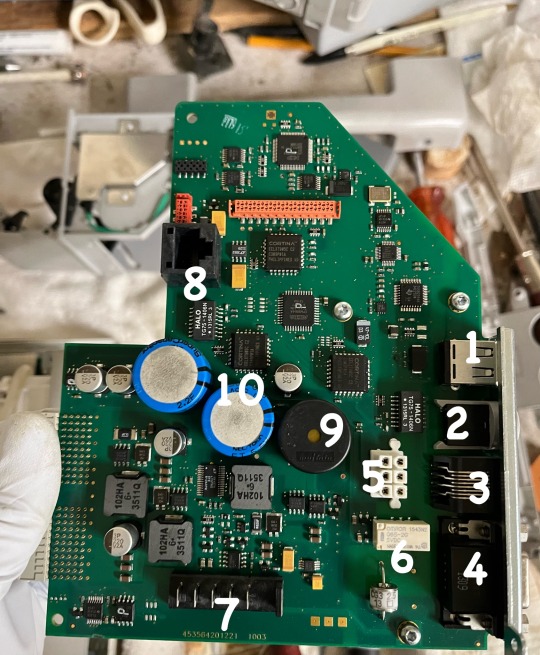
After removing a few more T-10 screws the power supply and the rear IO board slide right out. This is the rear IO board
1: USB port
2: Nurse call relay output
3: RJ45 Ethernet Jack
4: VGA video out
5: board to board interconnect for the power supply
6: Nurse call Relay, the actual Relay component
7: Battery contacts
8: An RJ45 Jack not accessible from the outside, if I had to guess this is either a management port, or it’s a backup port in case the one accessible from the outside breaks but qualified technicians still need Ethernet access to perform maintenance.
9: Piezoelectric buzzer, this will beep is the power supply suddenly gets disconnected and it will continue to beep for quite a while after the power supply is disconnected and even if there’s no battery on board
10: 2 super capacitors. Super capacitors have specs that are somewhere in between a battery and a capacitor. The larger one is rated at 2.2 farad and the smaller one is rated at 1 farad. Farad is the unit of measure for capacitance and it’s named after Michael Faraday. If I had to guess these serve 2 purposes. 1 is to make the power loss buzzer beep and the other is to keep the date and time and any configuration settings stored in volatile memory since there’s no CMOS battery. This is actually pretty smart because batteries die and often leak, but super capacitors don’t leak and corrode and they are ridiculously fast at charging up.

After removing the power supply, recorder driver board, and rear IO board this is what we are left with. The motherboard, the measurement module, the NBP pneumatic pump, and the LCD high voltage backlight board. It uses a fluorescent backlight so it needs a high voltage to make it light up, this can be anywhere from 500 to 1200 volts but they often provide very little current so touching it probably kill you but I still wouldn’t recommend it.

After removing the measurement module were left with just the backlight driver board, the motherboard, and the NBP pneumatic pump. There is a metal shield over the main components of the motherboard for EMI shielding.
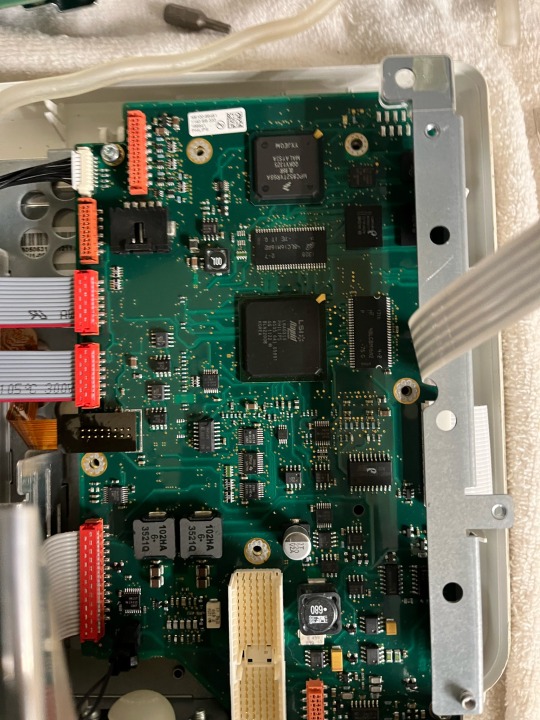
Removing the metal shield grants us access to the CPU (the largest chip on the board) what I assume is a graphics driver chip (the second largest square chip) and 2 EPROMs that are the memory for some software aspects.

Once everything is out we can get a look at everything
1: Battery
2: measurement module side plate
3: measurement module
4: printer
5: Rear IO board
6: printer driver board
7: power supply
8: everything else
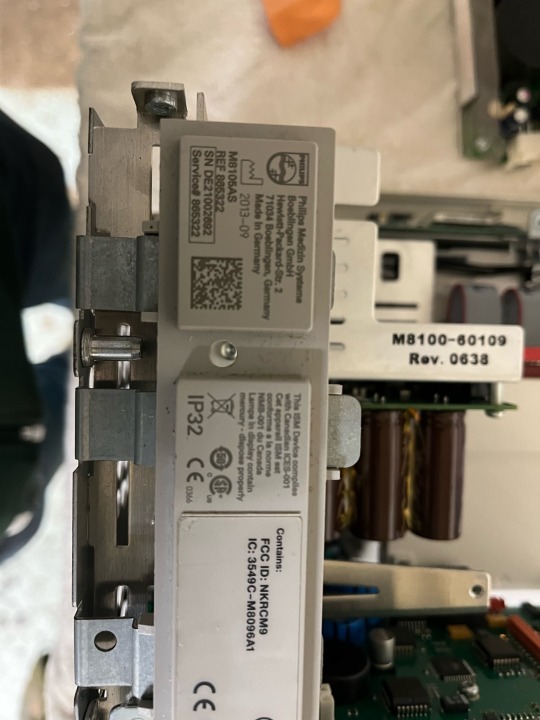
The attention to detail is amazing! That one little hole in the plastic just exists to access that screw inside. You can certainly tell that this device was never meant to be a consumer device. It’s built to be taken apart and serviced. All the screws are identical which makes disassembly and reassembly very easy. Unlike consumer products you can definitely tell that there was no expense spared in this things hardware design, that’s due to the fact that they know hospitals are going to pay the 5 figure price of the device because of its extreme quality, attention to detail and very long projected life cycle. Unlike consumer electronics it’s made in Germany and has a ton of hand assembly involved.
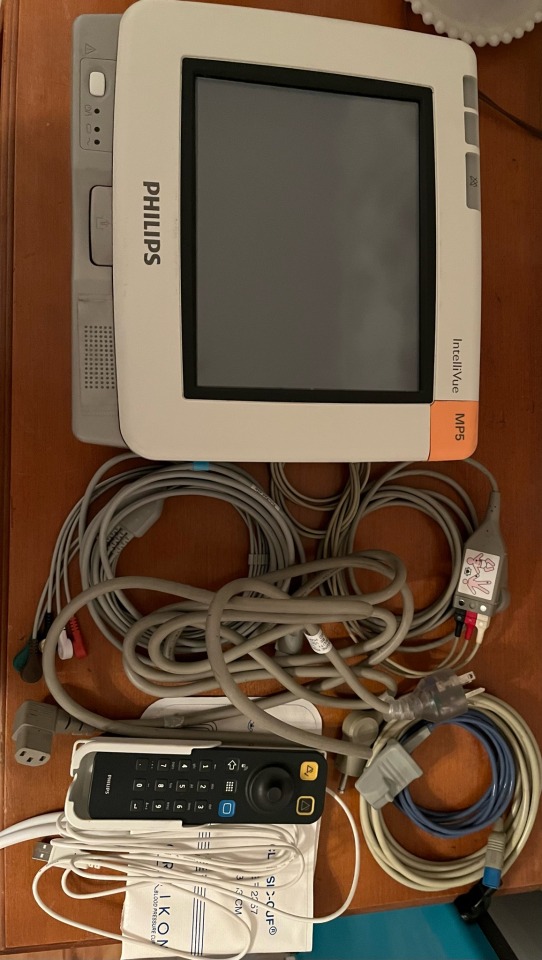
This is everything I have for mine. The monitor itself. 3 lead ECG cable. 5 lead ECG cable. Pulse oximeter. Hospital grade IEC power cable. Blood pressure hose. Adult arm blood pressure cuff. And the Intellivue remote. I got the remote today, idk why but people are selling them for super cheap on eBay. I paid $10 for it brand new in box. They usually go for like $500 from philips directly so I have no idea why people are selling them for so cheap. It does have to be plugged in via USB but it comes with a very long cable.
I finally got around to getting one of my servers to run the Intellivue XDS application. It’s a windows application meant to act as the server for Intellivue monitors. It also has a remote monitor function so you can view what’s on the monitor on the server, but it doesn’t work with the software version my monitor has. It can also log data but I spent 4 hours trying to setup the windows server needed to get that to work and just couldn’t get it to work. It’s probably due to the fact that the documentation on it is absolutely terrible.
4 notes
·
View notes
Text
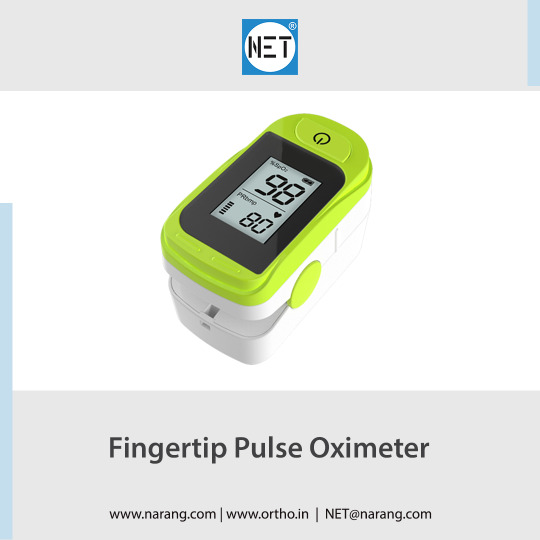
The NET brand DP2041A Fingertip Pulse Oximeter features a small and lightweight design with an LCD screen display for SpO2, PR, and Pulse bar, boasting low power consumption and a battery-low indicator. Know More
2 notes
·
View notes
Text
Are you looking for a pulse oximeter with exceptional battery life? Look no further than our comprehensive guide for the Best Pulse Oximeter Battery Life for Home Use! Our expert team has tested and reviewed the top oximeters on the market to bring you the most reliable and long-lasting options. From sleek designs to user-friendly interfaces, our guide has it all. Plus, with our helpful icon system, you can quickly and easily identify the key features of each product. Don't settle for a subpar oximeter - read our guide today and ensure you're getting the best battery life possible for all your at-home monitoring needs! Click now to read more.
2 notes
·
View notes
Text
BCI Pulse Oximeter Accessories
BCI pulse oximeter accessories are replacement parts for BCI pulse oximeters. Pulse oximeters are medical devices that clip onto a fingertip or earlobe to measure the amount of oxygen in your blood. They are used in hospitals, clinics, and at home to monitor people with respiratory problems, such as asthma or chronic obstructive pulmonary disease (COPD).
The BCI Pulse Oximeter Accessories available at Bttn, include a variety of components designed to enhance the functionality and usability of pulse oximeters, which are crucial for monitoring oxygen saturation in medical settings.
Durable Cables: Transmit data seamlessly with high-quality cables designed for reliable connectivity.
Protective Carrying Cases: Keep your pulse oximeter safe and secure during transport and storage with our convenient carrying cases.
Portable Printers: Print out your pulse oximetry readings for easy record-keeping and sharing with healthcare professionals.
Universal Chargers: Ensure your pulse oximeter is always ready to use with our universal chargers, compatible with a wide range of models.
Benefits
Enhanced Patient Care: With a variety of sensors and cables, healthcare providers can choose the best fit for their patients, ensuring accurate readings and better care.
Infection Control: Disposable sensors reduce the risk of cross-contamination between patients.
Durability and Reliability: High-quality materials and construction ensure that accessories withstand frequent use and harsh environments.
Convenience: Accessories like extension cables and mounting solutions improve the ease of use and flexibility of pulse oximeters in various settings.
BCI Pulse Oximeter Accessories: Features and Specifications
1. Wide Range of Sensor Options:
Reusable Sensors: These sensors are durable and designed for long-term use. They come in various sizes to accommodate different patient needs, including adult, pediatric, and neonatal options.
Disposable Sensors: Ideal for single-patient use to prevent cross-contamination, available in multiple sizes.
2. Sensor Cables and Extensions:
High-quality cables that ensure accurate data transmission from the sensor to the pulse oximeter.
Extension cables available to provide additional reach, enhancing flexibility in patient monitoring.
3. Mounting Solutions: Secure mounting brackets and stands to ensure the pulse oximeter and its sensors are properly positioned for optimal performance.
4. Power Supplies: Replacement batteries and power adapters to ensure continuous operation of the pulse oximeters, crucial in both clinical settings and home care scenarios.
5. Carrying Cases: Protective cases designed for the safe transport and storage of pulse oximeters and their accessories.
6. Calibration Tools: Tools and equipment for calibrating pulse oximeters to maintain their accuracy and reliability over time.
Additional Information:
The BCI Pulse Oximeter Accessories are designed to work with the BCI Pulse Oximeter. The accessories include cables, carrying cases, printers, and chargers.
Shop Now: BCI Pulse Oximeter Accessories
0 notes
Text
Zacurate 500BL Oxymètre de pouls du bout des doigts Moniteur de saturation en oxygène du sang avec piles incluses (bleu marine).
Cliquez sur le lien ci-dessous pour aller sur le site du marchand :
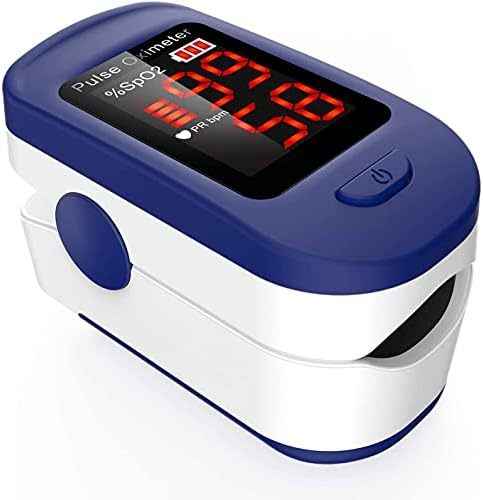
0 notes
Video
youtube
Santamedical Pulse Oximeter | How To Insert Batteries | Easy to carry | ...
0 notes
Text
Unveiling the Ultimate Senior-Friendly Exercise Gadgets
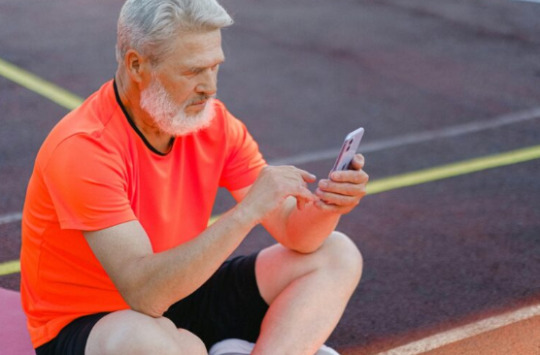
Regular exercise is essential for seniors to preserve good health and well-being. Fortunately, there are now fitness equipment created exclusively for older persons, which provide a variety of benefits to improve their exercise experience. These devices have monitoring and tracking features, allowing seniors to keep track of their progress and make changes to their routines as needed. They also provide fitness instruction with pre-programmed regimens and access to workout films, ensuring that elders exercise effectively and securely. Fitness gadgets also give incentive and accountability via reminders and notifications, assisting seniors in developing healthy habits and staying on track with their fitness goals. Furthermore, some devices provide social networking, allowing seniors to communicate with friends or join communities for further motivation and support. When selecting a fitness gadget for seniors, consider ease of use, comfort and wearability, battery life, accuracy and dependability, and interoperability with other gadgets. There are numerous exercise gadgets available on the market that cater to the unique needs of older individuals. For seniors with limited mobility, smart pedals, hand exercise balls, and resistance bands are recommended. These gadgets give low-impact leg exercises while also improving hand and grip strength. Seniors with chronic diseases can benefit from low-impact elliptical machines, which provide a full-body workout without putting stress on their joints. Pulse oximeters are essential for those with respiratory problems because they measure oxygen saturation during exercise. Smart scales can monitor weight, BMI, and other important information.
Finally, fitness equipment for seniors provide a variety of benefits that improve their workout experience and general health. Seniors can stay active, keep their independence, and live a full life by selecting the appropriate technology for their needs.
0 notes
Text
Wireless Vital Signs Monitoring: Unleashing the Potential of
Connectivity

Healthcare is going through a revolutionary change in a world driven by technology. One of the main drivers of this change is the use of wireless technology in vital sign monitoring. This change is improving patient care and paving the way for more accessible and efficient healthcare systems around the world. Traditionally, vital signs monitoring has involved bulky wired setups that restrict patient mobility and limit the real-time nature of data acquisition. The advent of wireless technology has brought about a revolutionary change, enabling medical professionals to monitor patient’s vital signs remotely and in real time. Home Care Products & Equipment Online in Muscat, Oman offers wireless vital signs monitoring systems that provide healthcare professionals with immediate access to a patient’s critical health data. Real-time updates allow medical professionals to react quickly to any abnormalities in vital parameters, such as heart rate, blood pressure, oxygen saturation, or other vital parameters. This proactive approach can be especially important during emergencies, ensuring timely interventions and potentially saving lives.
Here are some wireless vital signs monitoring devices to enhance your overall health.
CareSens N Blood Glucose Tests Strips
CareSens N Blood Glucose Test Strips offer an affordable and best-in-class solution for monitoring blood glucose levels. With a track record of fast and high performance, along with user-friendly features and reliable accuracy, CareSens N has become a global diabetic management solution trusted by millions across more than 80 countries over the past decade. CareSens N Blood Glucose Test Strips are FDA-approved and feature cutting-edge technology that emphasizes precision and accuracy in blood glucose measurement. Whether you are healthcare professional or individual managing diabetes, these test strips are a trusted companion for ensuring effective and reliable blood glucose monitoring. It only takes a minimal 0.5 µL sample for the detection, analysis, and correction of variables in every blood sample. As a result, users can feel confident in their monitoring process.
Fingertip Pulse Oximeter
A fingerprint pulse oximeter is a small, portable medical device that measures pulse rate and oxygen saturation levels in the blood (SPO2) non-invasively. This specific oximeter is made to be modeled on the fingertip, offering a quick and easy way to check vital signs. It has an LED screen that makes it easy to see the SPO2 and pulse rate values. The fingerprint pulse oximeter is very convenient and runs on two AA batteries. Its battery indicator further adds to its compactness, providing a visual alert about the remaining battery life. This ensures that the device is always ready for use, making it an excellent choice for those who need a reliable and portable solution for monitoring their vital signs. This feature improves user accessibility and makes it a great tool for people who need to regularly monitor their cardiovascular and respiratory health as well as healthcare professionals.
Infrared Ear Thermometer
The Infrared Ear Thermometer represents an advanced and convenient solution for accurate temperature measurement. This medical-grade device eliminates the need for expensive probe covers, offering a cost-effective and efficient approach to monitoring body temperature. Designed with an ear cover-free feature, the thermometer ensures a hygienic and hassle-free experience. Its light and handy build make it user-friendly and portable, providing a practical solution for use in various settings. One key feature is its ability to deliver precise measurements, making it a reliable tool for assessing body temperature. The incorporation of a large LED screen further enhances the user experience, allowing for easy and quick reading of temperature values. A significant feature of this thermometer is its dedication to environmental and safety awareness. It is mercury- and radiation-free, and it is compliant with health and environmental regulations. Apart from its safety and accuracy features, the infrared ear thermometer has an automatic alarm alert that promptly alerts users to high temperatures, thereby offering a heads-up on possible health risks.
Sphygmomanometer (Blood Pressure Measuring Apparatus)
The Sphygmomanometer, commonly known as a blood pressure measuring apparatus, is a vital medical device designed for accurately measuring blood pressure. It comes in two primary types: portable and desk-type, catering to various healthcare settings and needs. The portable sphygmomanometer provides flexibility for healthcare professionals to monitor blood pressure in different environments. Its compact and lightweight design makes it an ideal choice for on-the-go healthcare practitioners, enabling them to assess blood pressure levels conveniently and promptly during home visits or in non-clinical settings. On the other hand, the desk-type sphygmomanometer is a stationary device commonly found in clinical and medical office settings. This type of blood pressure measurement device is designed for stability and precision, ensuring accurate readings in a controlled environment. Both types of sphygmomanometers share the common goal of providing reliable blood pressure measurements. They typically consist of an inflatable cuff to momentarily stop blood flow and a pressure metre to measure the pressure within the artery. This fundamental design allows healthcare professionals to assess systolic and diastolic blood pressure, offering crucial insights into cardiovascular health.
Healthsouq stands as a reliable Shop Patient Monitoring & Vital Signs Devices Online in Muscat, Oman catering to the diverse needs of individuals seeking quality and accessible solutions for home healthcare. We ensure that essential home care products and equipment are easily accessible, contributing to the well-being and comfort of individuals in the comfort of their homes. While the adoption of wireless vital signs monitoring devices brings forth numerous advantages. Issues like data security and interoperability need to be addressed to fully unlock the potential of these devices. The array of wireless vital signs monitoring devices represents a leap forward in healthcare technology. Their ability to streamline data collection, enhance patient comfort, and empower remote monitoring is reshaping patient care. As these devices continue to evolve, they stand as a testament to the ongoing transformation of healthcare through the power of wireless connectivity.
0 notes
Text

#oximeter
#fingertipoximeter
1 note
·
View note
Text
Unveiling the Future: 5 Key Takeaways from CES 2024
The first publication of this article was in the German business and tech journal Marketing Scout, and can be found here: https://www.marketingscout.com/trends/ces-2024-publicis-sapient-erlaeutert-die-wichtigsten-tech-trends-fuer-verbraucher/. The English language version in which it was originally written is shown below for reader convenience.
The Consumer Electronics Show (CES) is a hub of technological innovation. From the omnipresence of AI to the rise of autonomous robots, home-based health tech, and other groundbreaking innovations, CES offered a glimpse into a future where technology is increasingly integrated into our daily lives. As my 17th consecutive CES draws to a close, here is a rundown of the broad themes I saw, heard, and frequently discussed with fellow attendees in Las Vegas at what is often billed as the world’s largest trade show.
1. AI is everywhere. AI will undoubtedly change the world. We should all keep our expectations in check, though: not all AI is created equal. Keeping in mind that everything that might possibly be called AI will be labeled as AI, frustratingly for the lay consumer there is no industry convention to discern machine learning from adaptive automation from full blown original thinking by a machine. In short, some AI is very sophisticated and intends to burrow into your life. Other AI is little more than a learning thermostat. However, on the packaging, they both will say the same thing: “Powered by AI.” From the perspective of the Consumer Technology Association (CTA), the trade group behind CES, explaining these distinctions to the masses is important, but probably best left to another day. For now, attendees seemed thrilled to have a new technology on the scene that genuinely delivers and has captured consumers’ imagination.
2. Robots are coming to help. Really. New this year were autonomous street sweepers that can self-fuel, take out their own trash and fill up their own water tanks. Also, fully autonomous robot baristas and bartenders. I didn’t try it myself, but a fellow convention-goer said her robot crafted-and-delivered latte was “excellent.” Next up were improved lawn and pool maintenance bots, security drones to monitor your property and recharge themselves without human intervention, and other robots tasked to sort mixed recyclables—but not before diligently emptying the drips from almost-empty cans or bottles that humans left behind. As pointed out in prior years, we humans can’t be relied upon to triple rinse.
3. Health tech is bringing versions of gear from your doctor’s office to your home. Seen on the CES floor this year were home-based: miniature urine lab appliances, respiratory monitors, devices to detect early signs of neuromuscular biomarkers, incontinence management systems, asthma management platforms, and a digital home stethoscope that your doctor can listen to remotely. If you’re in need of a blood draw, your new laser lancer device can make that process safe, pain-free and leaves behind the fear of error a distant memory. And that’s in addition to AFib detection and pulse oximeter capabilities that may already be in your smart watch.
4. CES is a car show, too, and that’s here to stay. The latest trends in automobile design—the term “software-defined vehicles” is central to this new way of thinking—mean that your car might be better compared with your smartphone than the station wagon you rode in the ‘way back’ as a kid. Increasingly cars will take advantage of over-the-air updates, power up opportunistically when you have access to a charger (whether that’s a full battery electric or hybrid drivetrain) and provide a driver/user experience centered on apps that you can collect or discard over time. Safety features are being added at a rapid clip, including several that use LiDAR to detect pedestrians, cyclists, and other road hazards. That same LiDAR telemetry is core to several driver assistance capabilities now, and eventually will be leveraged by self-driving vehicles, too. Level 5 autonomy isn’t here yet, but the industry is working on it. And when the open road calls, the latest auto campers will automatically connect themselves to your car’s trailer hitch in a docking procedure akin to a SpaceX Dragon capsule-to-ISS rendezvous.
5. AI took center stage, but there are other major innovations worth noting. Both Samsung and LG debuted transparent OLED TVs with eye-popping color and top-notch resolution. Speaking of resolution, your new TV isn’t waiting around for 8K content to materialize through your cable provider or streamer: your Samsung Tizen display will dynamically upscale existing content on the fly with magnificent results. Sustainability permeated every category of the show floor from the use of heat pumps in super-efficient washer/dryer combo appliances to sustainable, recycled paper-fiber based non-plastic bubble-wrap packing material alternatives from 3M. Tesla is no longer the only major supplier of consumer household-sized storage batteries that can connect to solar panels or be used to draw and store power from the grid at non-peak hours to be used later when rates are higher. And your home’s main breaker panel isn’t dodging innovation, either: watch for smart circuit breakers that can be added to your HomeKit, Alexa, Gosund, or Matter-compliant home automation platform.
In conclusion, the future is happening again. Most of it is handy, but as usual, the economic and practical value to each consumer is a mixed bag. In the health tech arena, some inexpensive home sensors might save your life, or help you live better for longer. That seems worthy of a swipe of the FSA card. There is legitimately cool and useful new tech that will make it to your local Best Buy, Target, Walmart, or online retailer in the coming days. As amazing as it looks, I’ll pass today on Samsung’s 110-inch transparent OLED screen for $150,000, but last year’s model at my nearest Costco is surprisingly affordable, if I can bear to see a blank, black screen when it’s powered off. That’s so 2023.
#ces#ces2024#AI#generativeAI#robots#autonomy#health tech#autos#HomeKit#Matter#Alexa#Gosund#3M#Tesla#LiDAR
0 notes
Text

I bought a companion for my Intellivue MP5
This is an Intellivue MP2, this is just the pic from the eBay listing. It’s in pretty rough cosmetic shape but apparently works just fine.
What’s the difference between this and the MP5? Honestly not much, it uses an external power supply, the battery is much smaller, it doesn’t have the built in printer, and it can’t display as many waves, but that’s about it for differences. The thing that sets the Philips monitors apart from all other brands and makes them so desirable for hospitals is the same reason people buy the expensive Apple products: The ecosystem. The Philips monitors are the only monitors on the market that are based off of monitors made over 40 years ago and everything on those monitors from 40 years ago exists on these along with a bunch of other stuff that’s been added. The other thing is their network capabilities. They are the only system on the market where when paired with the proper servers you can upload vitals data to a server and save it for later, you can transfer a patient from one unit to another just a with a few button pushes and then their information moves to the monitor in the unit they are being transferred to without having to bring the monitor from one unit to another. They continue to receive software updates no matter how old they are (provided the hospital has Philips certified IT personnel) they can communicate with tons of accessories. They can track over 200 different vital signs (this does require special equipment) they can communicate with ventilators and infusion pumps. And there’s tons of other things they can do.
I do want to say that I bought these with some extra money I made during the holidays putting up and taking down Christmas lights. I don’t just have money for these things lying around.
I’d like to give anyone who wants to buy one of these monitors some buying advice
1. Stay away from the MP2 and X2 their external power supplies almost never come with them for a good price, if you want one with the battery and power supply it will cost $500 at the minimum
2. To save some money on cables it’s good to know that HP and Agilent Viridia line of patient monitors use the same pulse oximeter and ECG cables which can save you some significant money on cablee
3. Unfortunately they are significantly harder to get your hands on outside the US. Most of the EBay listing for them are in the US and the sellers will only sell to people within the US. That’s not their fault the US government prohibits the export of a lot of technology. High end medical equipment, high end computer components, IR (thermal) cameras that shoot at over 5 FPS, and lots of other things are all extremely locked down in terms of exporting outside the US because they don’t want it to fall into the hands of China. In fact the FDA supposedly controls the sale of medical equipment in the US but I don’t really think they care about used medical equipment because I have absolutely no medical connections. I do live in the technology capital of the world so that might have something to do with it. On a side note when I say Silicon Valley is the technology capital of the world I’m not joking. Google, Apple, Facebook, Nvidia, Intel, Tesla, Ebay, Zoom, Hewlett-Packard, and many more of the world’s largest tech companies are headquartered here. It does make it a bit easier for me to get my hands on bleeding edge tech or tech that’s harder for most people to get. I have friends who work for Tesla who’ve met Elon, I’ve seen Steve Wozniak in a restaurant, and I know tons of engineers who’ve worked for these companies.
Another thing worthy of note on who I am: At 19 I’m an extremely bright engineer and have an extremely vast amount of knowledge in tons of areas of technology and study. But I’m also mentally unstable I have autism, ADHD, severe anxiety, and Bipolar disorder. I get sprits of depression and can’t seem to stick with anything. I went to university for a year for electrical engineering and dropped out. I dropped out for 2 reasons. I hated all the extra classes that I have no interest in. And I noticed I was a freshman yet I had similar knowledge to that of seniors graduating that year.
2 notes
·
View notes
Text
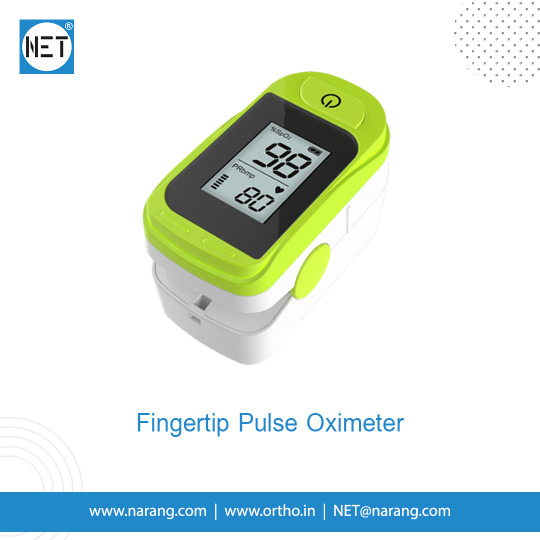
The DP2041A Fingertip Pulse Oximeter boasts a small and lightweight design, featuring an LCD screen that displays SpO2, PR, and Pulse bar information. With its low power consumption and battery-low indicator, it automatically powers off to conserve energy, making it a convenient choice for both pediatrics and adults. Plus, it runs on 2 AAA alkaline batteries for added convenience.
2 notes
·
View notes
Text
How the Best Fingertip Pulse Oximeter Makes Your Life Easier?
With advancements in technology, monitoring vital signs has become more accessible and convenient. The fingertip pulse oximeter is one such device that has gained immense popularity. This small, portable device has revolutionized health-tracking, making it easier and more efficient. Find out how the best fingertip pulse oximeter made in India can significantly improve the quality of your life.
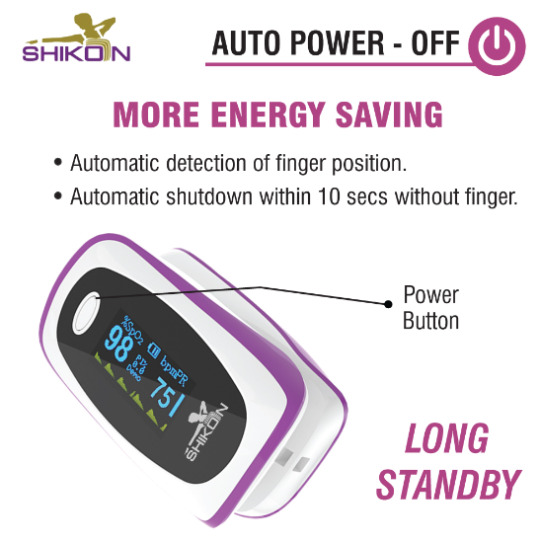
One-Click Operation
The one-click operation feature allows users to measure their oxygen saturation (SpO2) and pulse rate with just a simple press of a button. This eliminates the need for complicated setups and ensures that you can get accurate readings quickly and effortlessly. Whether you are at home, in the office, or on the go, the one-click operation makes health monitoring a seamless part of your routine.
Low-Battery Indicator
The best fingertip pulse oximeters come equipped with a low battery indicator, giving users a heads-up when it is time to replace or recharge the batteries. This simple yet crucial feature ensures that the device is always ready when you need it, preventing any interruptions in your health monitoring routine.
Pulse Beep Function
When you buy fingertip pulse oximeter, look for one with pulse beep function. For individuals with visual impairments or those who prefer not to constantly check the display, it can be highly useful. This feature produces a sound that corresponds to the pulse rate of the user, providing an audible indicator of his / her current health status. The pulse beep function enhances accessibility and allows a wider range of users to benefit from fingertip pulse oximetry without relying solely on visual cues.
Alert Alarm
Early detection of abnormal readings is crucial in critical situations. The best fingertip pulse oximeters are equipped with alert alarms that notify users of irregularities in oxygen saturation or pulse rate. This proactive approach to health monitoring ensures that you can take prompt action or seek medical attention when necessary, potentially preventing more severe health issues.
Auto Power Off
The auto power off feature in the best fingertip pulse oximeters helps conserve battery life by automatically shutting down the device after a period of inactivity. This not only extends the lifespan of the batteries but also ensures that the device is always ready for use when needed.
#FingertipPulseOximeterMadeInIndia#FingertipPulseOximeter#PulseOximeter#FingertipPulseOximeterPrice#FingertipPulseOximeterIndia#FingertipPulseOximeterPriceInIndia#DigitalFingertipPulseOximeter#BestFingertipPulseOximeterInIndia#FingertipPulseOximeterManufacturersInIndia#BestPulseOximeter#BestFingertipPulseOximeterIndia
0 notes